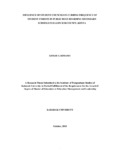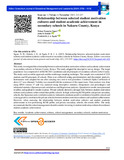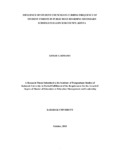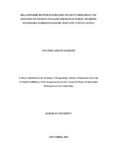INFLUENCE OF STUDENT COUNCILS IN CURBING FREQUENCY OF STUDENT UNRESTS IN PUBLIC BOYS BOARDING SECONDARY SCHOOLS IN ELGON SUB-COUNTY, KENYA
Abstract
The Government of Kenya, through the Ministry of Education, established Student Councils in Secondary Schools in 2009 to assist schools to manage student affairs. Yet, student unrests which are manifested in strikes, go-slows, rioting, burning of school property and violent behaviors still continue unabated. During the period 2014-2017, schools in Bungoma County, Kenya, witnessed an unprecedented rise in incidences of student unrests leading to destruction of property and loss of life. The problem this study sought to address was the rising number of student unrests in public boys boarding secondary schools in Elgon Sub-county, Kenya. Therefore, the purpose of this study was to assess the influence of student councils in curbing the frequency of student unrests in public boys boarding secondary schools in Elgon Sub-county, Kenya. The study was based on Social Systems Theory. In the conceptual framework, the frequency of student unrests depends on roles played by student councils namely: decision making, communication, disciplinary and guidance and counseling roles. The study adopted a descriptive survey design. There are only 3 Public Boys Boarding Secondary Schools. Therefore, purposive sampling technique was used to sample the three secondary schools. Proportional sampling technique was used to sample respondents of students and members of student councils. The target population for students was 750 while that of members of student councils was 78. Using Krejcie and Morgan Table of determination of sample size, 254 Students and 66 Student Council members constituted the sample size. Simple random sampling technique was used to sample respondents according to the predetermined sample sizes. The study used Likert type Students' Questionnaire and Questionnaire for Members of Student Councils as research instruments. Descriptive statistics namely, means, frequencies and percentages were computed. Inferential statistics was derived from the data. The instruments were piloted and tested for reliability using test-re-test method. Validation was done by experts. Results were presented in tables and diagrams. The study revealed that there exists a negative, strong and statistically significant relationship between decision making roles played by student councils and the frequency of student unrests (r= 0.809**; p<0.01). The study reported a negative and statistically significant relationship between communication roles played by student councils and the frequency of student unrests (r= -0.848**; p<0.01). Similarly, there existed negative and statistically significant relationship between disciplining roles played by student councils and the frequency of student unrests (r= -0.758**; p<0.01). It was found out that there is a negative and statistically significant relationship between guidance and counseling roles played by student councils and frequency of student unrests (r= -0.646**; p<0.01). Based on the findings of this research study, it is concluded that if student councils participate in decision making, peer guidance and counseling, communicate student problems to school management and assist in disciplining of other students, frequency of student unrests will be curbed in Public Boys Boarding Secondary Schools in Elgon Sub-county. The study recommends that student councils be thoroughly prepared in their roles through seminars, workshops and regular meetings with the principals. Suggestions made by student councils on students’ grievances should be given a lot of weight and importance. The schools under study should carry out continuous benchmarking with schools of excellence who have managed to handle the problem of students’ unrests.
Collections
Related items
Showing items related by title, author, creator and subject.
-
Relationship between selected student motivation cultures and student academic achievement in secondary schools in Nakuru County, Kenya
Ngare, Nelson Nyang’au; Ochola, John N.; Ngala, Fredrick B. J. A. (Editon Consortium Journal of Educational Management and Leadership, 2023-11)This study investigated the relationship between selected student motivation cultures and academic achievement in secondary schools in Nakuru County, Kenya. The study adopted the descriptive survey design. The target population ... -
INFLUENCE OF STUDENT COUNCILS IN CURBING FREQUENCY OF STUDENT UNRESTS IN PUBLIC BOYS BOARDING SECONDARY SCHOOLS IN ELGON SUB-COUNTY, KENYA
KIMAME, LESLIE S. (KABARAK UNIVERSITY, 2018-10)The Government of Kenya, through the Ministry of Education, established Student Councils in Secondary Schools in 2009 to assist schools to manage student affairs. Yet, student unrest which are manifested in strikes, go-slows, ... -
RELATIONSHIP BETWEEN INCREASED STUDENT ENROLMENT AND DELIVERY OF STUDENT WELFARE SERVICES IN PUBLIC BOARDING SECONDARY SCHOOLS IN KISUMU WEST SUB- COUNTY, KENYA
ONG’INJO, ATIENO JACKLINE (Kabarak University, 2023-11)The issue of students’ enrolment and student welfare has been the concern of education researchers around the globe. This study attempted to establish the relationship between increased student enrolment and delivery of ...




